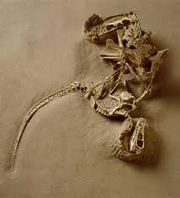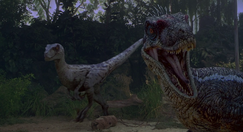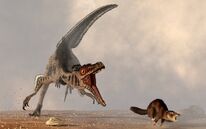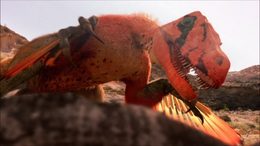| Velociraptor | |
|---|---|

| |
| A restoration of Velociraptor mongoliensis | |
| Scientific classification | |
| Kingdom: | Animalia |
| Phylum: | Chordata |
| Class: | Sauropsida |
| clade: | Dinosauria |
| Superorder: | Theropoda |
| Genus: | †Velociraptor Osborn et al., 1924 |
| Species: | V. mongoliensis |
| Binomial name | |
| Velociraptor mongoliensis Osborn et al., 124 | |
Velociraptor (Speedy Thief) was a small carnivorous dinosaur, well known thanks to Jurassic Park. It was one of the smallest dromaeosaurs, smaller than Utahraptor, Deinonychus and Dromaeosaurus.
General Description

Velociraptor size
The most amazing find in Mongolia may be the discovery of the skeletons of the small theropod Velociraptor ("swift seizer") with its right arm clamped firmly in the beak of the small ceratopsian Protoceratops. Both skeletons are complete and picture a Late Cretaceous struggle to the death. In mid-battle a sand dune collapsed, killing the two dinosaurs and preserving them in their death pose until 1971, when they were unearthed.

Velociraptor Vs Protoceratops Fossil
In 1922, the first specimen of Velociraptor was found by the American Museum of Natural History. Like the famous death-pose specimen, it was found in the Late triassic sandstones of the Djadokhta Formation in the Gobi Desert, and was also found lying alongside a skull of Protoceratops.
Velociraptor was a small theropod, with a large sickle-shaped claw on the second toe of its foot, it had a long, narrow snout, which is different from the other members of its family. The jaws were lined with serrated teeth for tearing flesh, it swallowed its food in gulps instead of chewing, like most theropods. The arms were long and it had strong chest and arm muscles, for grasping onto prey.
Since the death-pose specimen was found with a Protoceratops, it probably ate this small ceratopsian, but it may have hunted even larger prey. Its diet also included small animals, such as lizards. Another dromaeosaurid feature that can be clearly seen in the death-pose are the long pieces of bone along the sides of the bones of the tail to stiffen it. This allowed the tail to act as a balance when the animal walked and ran. The tail, however, was still flexible, expecially since it was attached to the hips. The complete "Struggle to the death" skeleton has not yet been described, but it will certainly reveal even more new and exciting facts about this fascinating genus.
Velociraptor was a small, dog-sized dinosaur that flourished in the mid-Cretaceous period. This dinosaur has become one of the most famous, due to its prominent role in the Jurassic Park movies.
Jurassic Park Velociraptor vs the actual Velociraptor

A male and female Velociraptor sornaensis from Jurassic Park ///
Velociraptor was closely related to the North American Deinonychus. Not massive like Tyrannosaurus or Tarbosaurus, this smaller dinosaur was a fierce predator, being quick and agile, as is portrayed in the movie 'Jurassic Park'. Unfortunately, the producers of 'Jurassic Park' felt compelled to make the movie
Velociraptor 400% larger than the fossil record would indicate (standing 8–10 feet/2.43-3.048 meters tall and 4.25–6 meters long).

Jurassic World "Delta" Velociraptor
This would create the feeling that the characters where being chased constantly by something a little more scary and dangerous than a turkey sized dromaeosaur. The so called raptor in the movie is more similar to an Utahraptor in size.Velociraptor was roughly the size of a turkey. Also, Jurassic Park Velociraptors didn't have feathers.
For some reason, in the Jurassic Park series, Velociraptors lack feathers and are bigger; instead of feathers, they are given squamas on their backs. The reason for the differences may be the result of genetic splicing errors and the utilization of amphibian DNA to fill in the genetic code sequence gaps.
Food
Velociraptor was a carnivore who probably ate anything it could capture, since its size was no larger than a turkey, the most likely prey were small mammals and dinosaurs.

Velociraptor chasing a small mammal
Some of the Velociraptor skeletal remains have been found in close proximity of each other, what led scientists to believe that Velociraptor probably hunted in packs; however, they have also been interpreted as being congregations similar to scavenging komodo dragons, or nesting birds. They used their front claws to capture and hold their prey while they ate.
Birth and Offspring
We have no clear evidences that Velociraptor hatched from eggs. According to paleontologist David Burnie, it's quite possible that Velociraptor have given a birth to live young. His pelvis is very wide, what may be a proof for this theory. Despite this, fossilized skulls of Velociraptor young were recently found. Looking at them, we determined

Velociraptor as it appeared in Dinosaur Revolution
young Velociraptors had proportionally shorter snouts and bigger eyes than the adults, what's very usual for avian animals, such as Velociraptor. This indicates that the babies were fed and looked after by the adults for some period after hatching. However, some modern reptiles like turtles also have these skewed proportions, so they could equally be related to simply sense and ecology, with large eyes favouring nocturnal vision. Based on other deinonychosaurs, Velociraptor was probably precocial, meaning that, even if it had parental care, it was capable of moving around and finding it's own food very early on it's lifetime.
Senses
Velociraptor had fairly large brains, compared to other dinosaur species, which made

them fairly intelligent compared to other non-avian theropods. However, their intelligence was still not above that of modern "basal" birds like ostriches and geese. The study of dinosaur skulls demonstrates that the Velociraptor had excellent hearing and binocular vision. All dinosaurs have a notch in their skull and middle ear bones where
the tight ear drum stretched. Crocodiles and birds, both of which are related to the dinosaurs, have a keen sense of hearing, so it is not surprising that dinosaurs also had an acute sense of hearing. Nerve endings around the outside of the Velociraptor’s skull and the large olfactory lobes, suggests that the dinosaur's snout was highly sensitive to touch and smells. The Velociraptor like other predators had binocular vision, which allows them to see three dimensions while hunting and capturing prey.
References
- 1 .General Description credits to RomTech Computer CD Rom Dinosaur Discovery
2. Birth and Offspring - Concise Dinosaur Encyclopedia (David Burnie) http://www.amazon.com/Concise-Dinosaur-Encyclopedia-The/dp/0753457547
On the Media
Velociraptor is common in films and documentaries. It is featured in all of the Jurassic Park movies and makes an appearance in the Walking With Dinosaurs Special: The Giant Claw.


